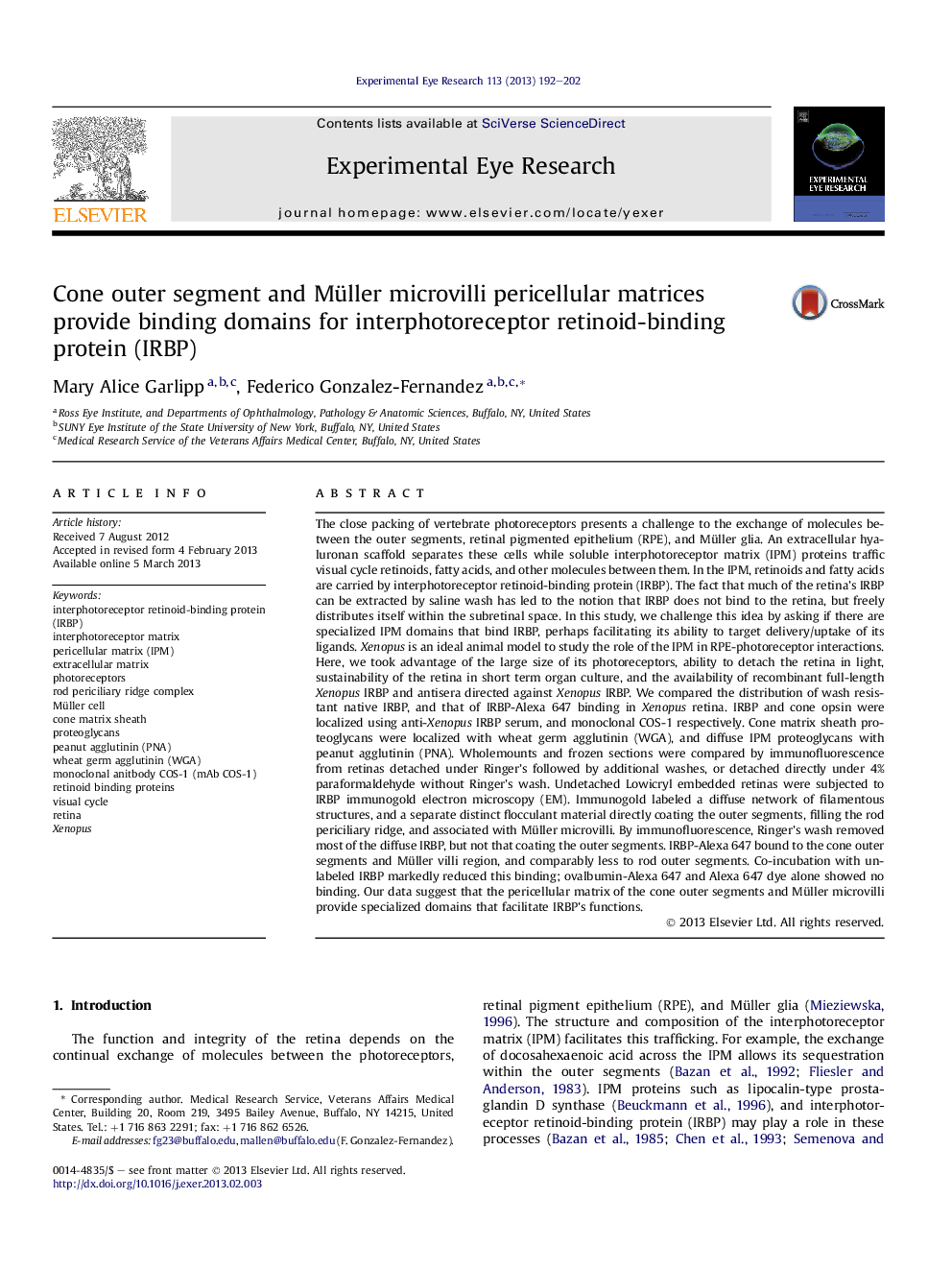| کد مقاله | کد نشریه | سال انتشار | مقاله انگلیسی | نسخه تمام متن |
|---|---|---|---|---|
| 6197288 | 1602609 | 2013 | 11 صفحه PDF | دانلود رایگان |

The close packing of vertebrate photoreceptors presents a challenge to the exchange of molecules between the outer segments, retinal pigmented epithelium (RPE), and Müller glia. An extracellular hyaluronan scaffold separates these cells while soluble interphotoreceptor matrix (IPM) proteins traffic visual cycle retinoids, fatty acids, and other molecules between them. In the IPM, retinoids and fatty acids are carried by interphotoreceptor retinoid-binding protein (IRBP). The fact that much of the retina's IRBP can be extracted by saline wash has led to the notion that IRBP does not bind to the retina, but freely distributes itself within the subretinal space. In this study, we challenge this idea by asking if there are specialized IPM domains that bind IRBP, perhaps facilitating its ability to target delivery/uptake of its ligands. Xenopus is an ideal animal model to study the role of the IPM in RPE-photoreceptor interactions. Here, we took advantage of the large size of its photoreceptors, ability to detach the retina in light, sustainability of the retina in short term organ culture, and the availability of recombinant full-length Xenopus IRBP and antisera directed against Xenopus IRBP. We compared the distribution of wash resistant native IRBP, and that of IRBP-Alexa 647 binding in Xenopus retina. IRBP and cone opsin were localized using anti-Xenopus IRBP serum, and monoclonal COS-1 respectively. Cone matrix sheath proteoglycans were localized with wheat germ agglutinin (WGA), and diffuse IPM proteoglycans with peanut agglutinin (PNA). Wholemounts and frozen sections were compared by immunofluorescence from retinas detached under Ringer's followed by additional washes, or detached directly under 4% paraformaldehyde without Ringer's wash. Undetached Lowicryl embedded retinas were subjected to IRBP immunogold electron microscopy (EM). Immunogold labeled a diffuse network of filamentous structures, and a separate distinct flocculant material directly coating the outer segments, filling the rod periciliary ridge, and associated with Müller microvilli. By immunofluorescence, Ringer's wash removed most of the diffuse IRBP, but not that coating the outer segments. IRBP-Alexa 647 bound to the cone outer segments and Müller villi region, and comparably less to rod outer segments. Co-incubation with unlabeled IRBP markedly reduced this binding; ovalbumin-Alexa 647 and Alexa 647 dye alone showed no binding. Our data suggest that the pericellular matrix of the cone outer segments and Müller microvilli provide specialized domains that facilitate IRBP's functions.
⺠The outer segment, and Müller cell villi pericellular matrices sequester IRBP. ⺠Pericellular IRBP resists saline wash compared to that in the diffuse IPM scaffold. ⺠IRBP-Alexa 647 binds to the cone, and Müller microvilli pericellular matrices. ⺠The pericellular matrix may provide binding domains key to IRBP's functions.
Journal: Experimental Eye Research - Volume 113, August 2013, Pages 192-202